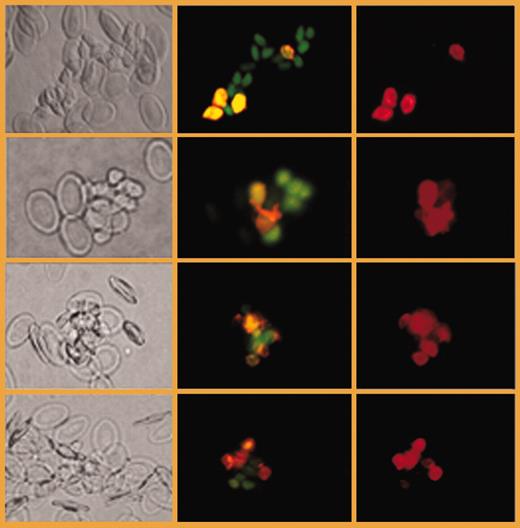Comment on Thattaliyath et al, page 118
Two populations of thrombocytes have been distinguished in zebrafish that appear to play different roles in arterial thrombus formation.
Thattliyath and colleagues have shown independent clustering of young and mature thrombocytes in zebrafish, and have demonstrated in an elegant series of experiments that young thrombocytes initiate the formation of arterial thrombus in vitro and in vivo. This work was facilitated by the observation that a lipophilic dye DiI-C18 preferentially labels young thrombocytes, allowing them to be distinguished from their more mature counterparts. Thus, the characteristics of these different populations could be investigated in more detail.FIG1
Thrombocyte clustering. See the complete figure in the article beginning on page 118.
Thrombocyte clustering. See the complete figure in the article beginning on page 118.
As instigators of clot formation, young thrombocytes appear to have several things going for them: they have a higher receptor density and also are functionally more active as demonstrated by P-selectin levels, annexin V binding, and the release of calcium after adenosine diphosphate (ADP) activation. These cells cluster with themselves initially. Though more slowly activated, older thrombocytes also seem to first cluster with themselves. Subsequently, mosaic aggregates of young and old thrombocytes appear in the clot.
The work by Thattliyath et al raises a number of interesting questions. What are the specific molecular and cellular changes that take place as platelets mature? What role do each of the platelet populations play in normal hemostasis? Although the authors have identified a decline in the number of surface receptors as one indication of platelet aging, there are undoubtedly other changes that take place as well. In addition, the authors suggest that older platelets may play a more structural role; however, this remains speculative.
The system that Thattliyath et al have developed should facilitate further investigation into the details of platelet function through genetic manipulation and analysis of the resultant cell biology. This work will eventually lead to a better understanding of the role of different platelet populations. If the findings in zebrafish are found to be conserved in mammalian systems, these findings could have significant clinical relevance for the field of hemostasis and thrombosis.
It has been recognized for some time both experimentally and clinically that young platelets can have advantageous hemostatic properties. This has been illustrated experimentally in a rabbit model, and observationally in patients with immune thrombocytopenic purpura.1 However, whether such properties result solely from the larger size of the platelets or whether they are due to different inherent functional properties is not fully known. A better understanding of whether size, functionality, or a combination of the two is relevant for optimal hemostasis could eventually facilitate the development of more optimal techniques for platelet transfusion. In addition, understanding the role that young platelets play in clot formation could open the way for the development of novel antithrombotic agents aimed specifically at reducing the activity of this population of cells. ▪


This feature is available to Subscribers Only
Sign In or Create an Account Close Modal